SINGER 3221 User Manual [ru]
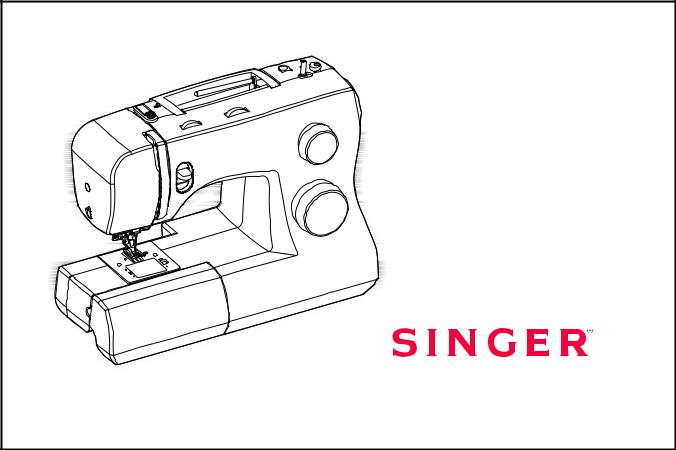
3321 Instruction Manual
IMPORTANT SAFETY INSTRUCTIONS
When using an electrical appliance, basic safety should always be followed, including the following:
Read all instructions before using this sewing machine.
DANGER - To reduce the risk of electric shock:
1.An appliance should never be left unattended when plugged in.
2.Always unplug this appliance from the electric outlet immediately after using and before cleaning.
3.Always unplug before re-lamping. Replace bulb with same type rated 10 watts (110-120V area) or 15 watts (220-240V area).
WARNING - To reduce the risk of burns, fire, electric shock, or injury to persons:
1.Do not allow to be used as a toy. Close attention is necessary when this appliance is used by or near children.
2.Use this appliance only for its intended use as described in this manual. Use only attachments recommended by the manufacturer as contained in this manual.
3.Never operate this appliance if it has a damaged cord or plug, if it is not working properly, if it has been dropped or damaged, or dropped into water. Return the appliance to the nearest authorized dealer or service center for examination, repair, electrical or mechanical adjustment.
4.Never operate the appliance with any air openings blocked. Keep ventilation openings of the sewing machine and foot controller free from accumulation of lint, dust, and loose cloth.
5.Keep fingers away from all moving parts. Special care is required around the sewing machine needle.
6.Always use the proper needle plate. The wrong plate can cause the needle to break.
7.Do not use bent needles.
8.Do not pull or push fabric while stitching. It may deflect the
needle causing it to break.
9.Switch the sewing machine off ("O") when making any adjustments in the needle area, such as threading needle, changing needle, threading bobbin, or changing presser foot, and the like.
10.Always unplug sewing machine from the electrical outlet when removing covers, lubricating, or when making any other user servicing adjustments mentioned in the instruction manual.
11.Never drop or insert any object into any opening.
12.Do not use outdoors.
13.Do not operate where aerosol spray products are being used or where oxygen is being administered.
14.To disconnect, turn all controls to the off ("O") position, then remove plug from outlet.
15.Do not unplug by pulling on cord. To unplug, grasp the plug, not the cord.
16.The sound pressure level under normal operating conditions is 75dB(A).
17.Please turn off the machine or unplug when the machine is not operating properly.
18.Never place anything on the foot controller.
19.If the supply cord that is fixed with foot controller is damaged, it must be replaced by the manufacturer or its service agent or a similar qualified person in order to avoid a hazard.
20.This appliance is not intended for use by persons (including children) with reduced physical, sensory or mental capabilities, or lack of experience and knowledge, unless they have been given supervision or instruction concerning use of the appliance by a person responsible for their safety.
21.Children should be supervised to ensure that they do not play with the appliance.
SAVE THESE INSTRUCTIONS
This sewing machine is intended for household use only.

Congratulations
As the owner of a new Singer sewing machine, you are about to begin an exciting adventure in creativity. From the moment you first use your machine, you will know you are sewing on one of the easiest to use sewing machines ever made.
May we recommend that, before you start to use your sewing machine, you discover the many features and the ease of operation by going through this instruction book, step by step, seated at your machine.
To ensure that you are always provided with the most modern sewing capabilities, the manufacturer reserves the right to change the appearance, design or accessories of this sewing machine when considered necessary.
SINGER is a registered trademark of The Singer Company Limited or its affiliates. © 2010 The Singer Company Limited or its affiliates. All rights reserved.

List of Contents |
|
Machine Basics |
|
Principle Parts of the Machine.............................................................................................................................................. |
2/3 |
Connecting Machine to Power Source .................................................................................................................................... |
4 |
Two Step Presser Foot Lifter ................................................................................................................................................... |
5 |
Accessories ............................................................................................................................................................................. |
6 |
Threading the Machine |
|
Winding the Bobbin ................................................................................................................................................................. |
7 |
Inserting the Bobbin ................................................................................................................................................................ |
8 |
Threading the Upper Thread ................................................................................................................................................... |
9 |
Automatic Needle Threader .................................................................................................................................................. |
10 |
Raising the Bobbin Thread .................................................................................................................................................... |
11 |
Thread Tension...................................................................................................................................................................... |
12 |
Sewing |
|
How to Choose Your Pattern ................................................................................................................................................. |
13 |
Stitch Width Dial & Stitch Length Dial ................................................................................................................................... |
14 |
Sewing Straight Stitch ........................................................................................................................................................... |
15 |
Reverse Sewing/Removing the Work/Cutting the Thread ..................................................................................................... |
16 |
Choosing Stretch Stitch Patterns .......................................................................................................................................... |
17 |
Blind Hem .............................................................................................................................................................................. |
18 |
Buttonholes ........................................................................................................................................................................... |
19 |
Sewing on Buttons ................................................................................................................................................................ |
20 |
General Information |
|
Installing the Removable Extension Table............................................................................................................................. |
21 |
Attaching the Presser Foot Shank......................................................................................................................................... |
22 |
Needle/Fabric/Thread Chart .................................................................................................................................................. |
23 |
Darning Plate......................................................................................................................................................................... |
24 |
Maintenance and Troubleshooting |
|
Inserting & Changing Needle ................................................................................................................................................ |
25 |
Changing the Bulb ................................................................................................................................................................. |
26 |
Troubleshooting Guide .......................................................................................................................................................... |
27 |
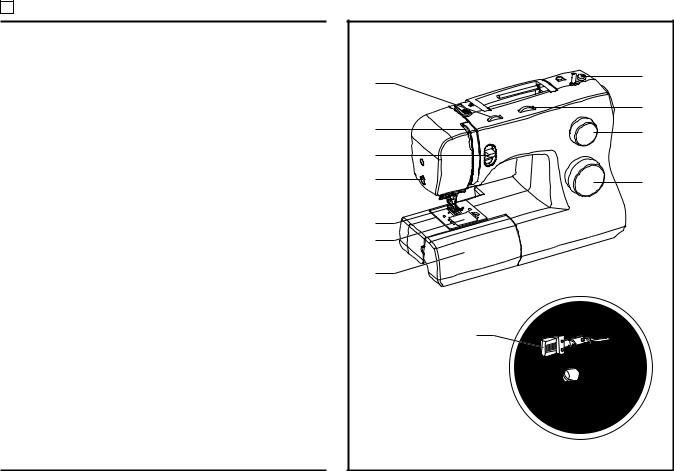
Principal Parts of the Machine
1.Thread tension dial
2.Thread take-up lever
3.Reverse sewing lever
4.Thread cutter
5.Presser foot
6.Needle plate cover
7.Removable extension table/ accessory storage
8.Bobbin stopper
9.Stitch width dial
10.Stitch length dial
11.Pattern selector dial
12.Automatic threader
1 |
8 |
|
|
|
9 |
2 |
10 |
3 |
|
4 |
11 |
5 |
|
6 |
|
7 |
|
|
12 |
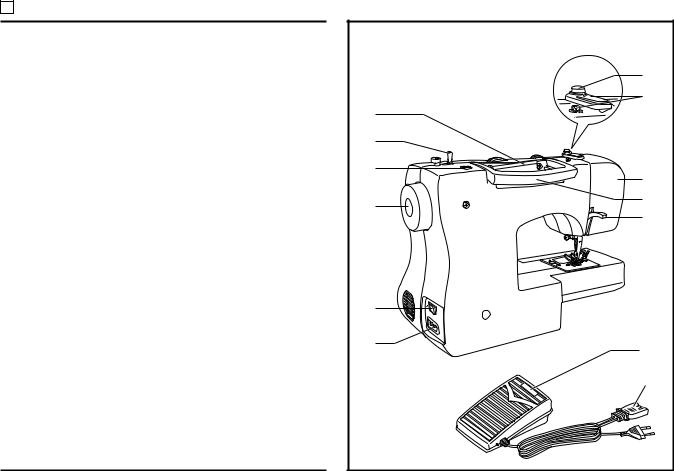
Principal Parts of the Machine
13.Horizontal spool pin
14.Bobbin winding spindle
15.Hole for auxiliary spool pin
16.Handwheel
17.Power and light switch
18.Main plug socket
19.Bobbin thread guide
20.Upper thread guide
21.Face plate
22.Handle
23.Presser foot lifter
24.Foot speed control
25.Power cord
|
|
|
|
|
|
|
|
|
|
|
|
|
|
|
|
|
|
|
|
|
|
|
|
|
|
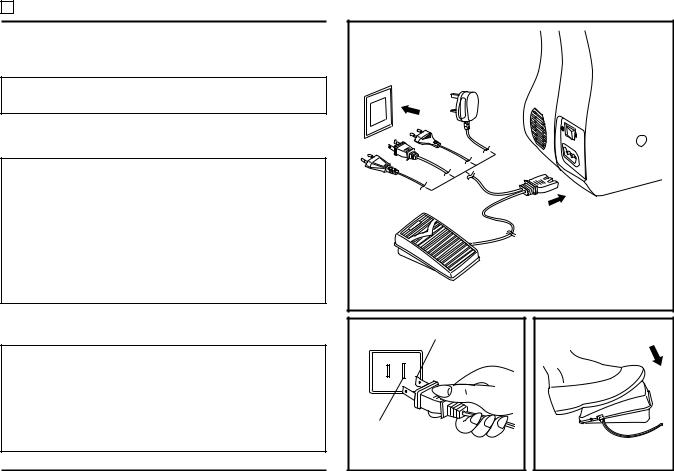
Connecting Machine to Power Source
Connect the machine to a power source as illustrated. (1) This appliance is equipped with a polarized plug which must be used with the appropriate polarized outlet. (2)
Attention:
Unplug power cord when machine is not in use.
Foot control
The foot control pedal regulates the sewing speed. (3)
Attention:
Consult a qualified electrician if in doubt of how to connect machine to power source.
Unplug power cord when machine is not in use.
The foot control must be used with the appliance by KD1902 (110-120V area)/ KD-2902 (220-240V area) manufactured by ZHEJIANG FOUNDER MOTOR CORPORATION LTD. (China)
4C-326G(230V area) manufactured by Wakaho Electric Ind. Co., Ltd. (Vietnam)
Sewing light
Press main switch (A) to " l " for power and light.
IMPORTANT NOTICE
For appliance with a polarized plug (one blade is wider than the other). To reduce the risk of electric shock, this plug is intended to fit in a polarized outlet only one way. If it does not fit fully in the outlet, reverse the plug. If it still does not fit, contact a qualified electrician to install the proper outlet. Do not modify the plug in any way.
Polarized attachment plug
Conductor intended to be grounded
to be grounded
|
|
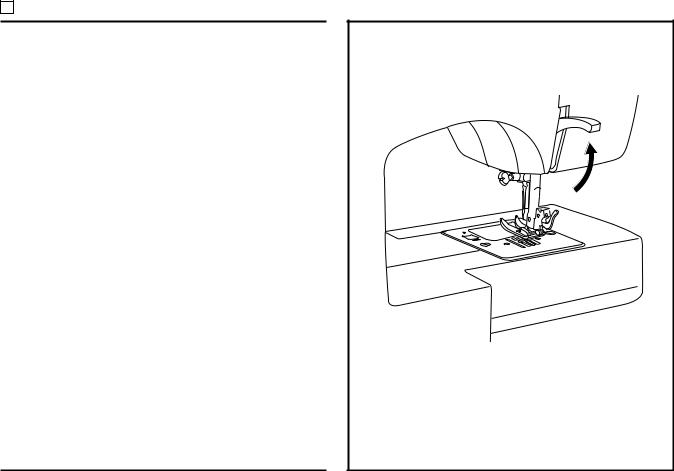
Two Step Presser Foot Lifter
When sewing several layers or thick fabrics, the presser foot can be raised to a higher position for easy positioning of the work. (A)
A |
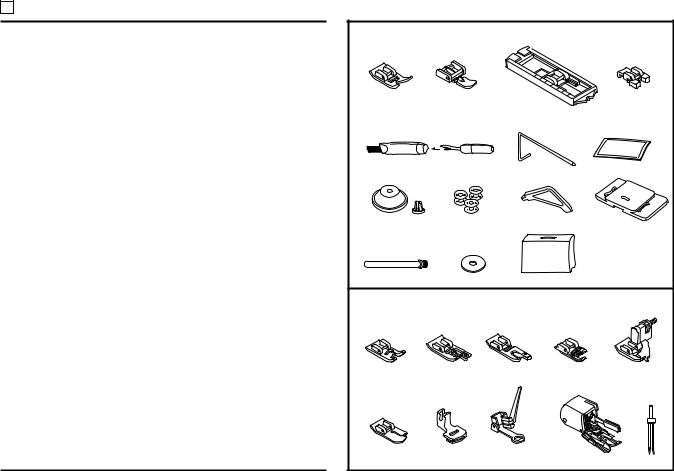
Accessories
Standard accessories (1)
a.All purpose foot
b.Zipper foot
c.Buttonhole foot
d.Button sewing foot
e.Seam ripper/ brush
f.Edge/ quilting guide
g.Pack of needles
h.Spool holders
i.Bobbin (3x)
j.L-screwdriver
k.Darning plate
l.Auxiliary Spool Pin
m.Spool pin felt
n.Soft cover
Optional accessories (2)
(These 10 accessories are not supplied with this machine; they are, however, available for purchase from your authorized retailer.)
o.Satin stitch foot
p.Overcasting foot
q.Hemmer foot
r.Cording foot
s.Blind hem foot
t.Quilting/ straight stitch foot
u.Gathering foot
v.Darning/ embroidery foot
w.Even Feed foot
x.Twin needle
1 Standard accessories |
|
|
||
a |
b |
c |
|
d |
006918008 |
006905008 |
006909008 |
|
006914008 |
e |
|
f |
g |
|
h |
i |
j |
k |
|
l |
m |
n |
|
|
2 Optional accessories |
|
|
||
o |
p |
q |
r |
s |
006172008 |
006907008 |
006900008 |
006813008 |
006904008 |
t |
u |
v |
w |
x |
006916008 |
006917008 |
006016008 |
0061850081 |
|
6
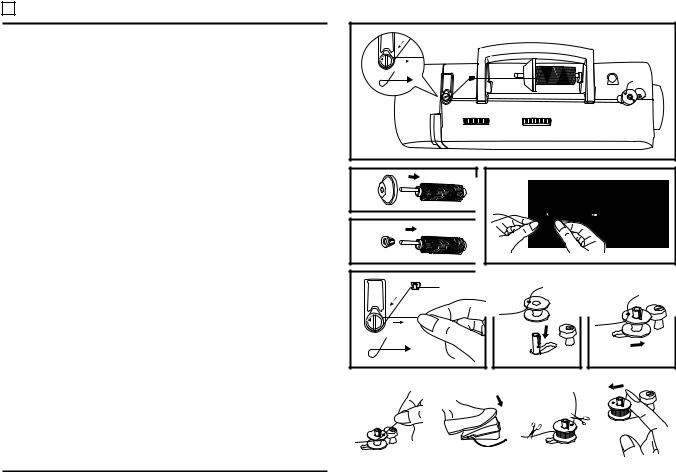
Winding the Bobbin
-Place thread and corresponding spool holder on to spool pin. (1/2)
-Snap thread into thread guide. (3)
-Wind thread clockwise around bobbin winder tension discs. (4)
-Thread bobbin as illustrated and place on spindle. (5)
-Push bobbin spindle to right. (6)
-Hold thread end. (7)
-Step on foot control pedal. (8)
-Cut thread. (9)
-Push bobbin spindle to left (10) and remove.
1 |
|
2 |
3 |
Please Note: |
|
|
|
When the bobbin winder spindle is in "bobbin winding" |
|
|
|
position, the machine will not sew and the hand wheel will |
|
|
|
not turn. To start sewing, push the bobbin winder spindle to |
|
|
|
the left (sewing position). |
4 |
5 |
6 |
7 |
|
8 |
|
9 |
|
10 |
7
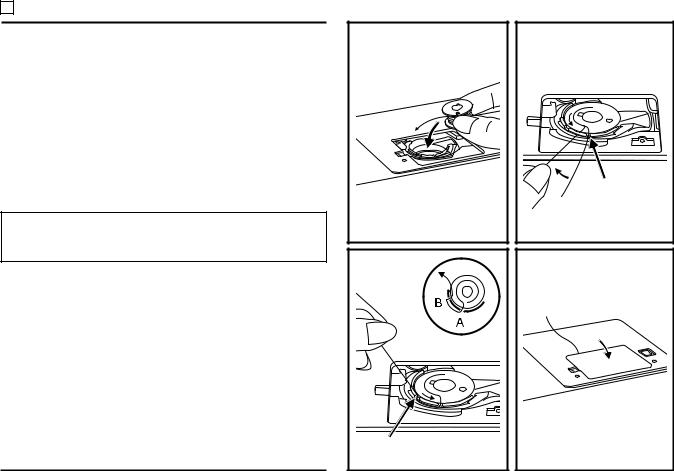
Inserting the Bobbin
When inserting or removing the bobbin, the needle must be fully raised.
1.Insert the bobbin in the bobbin case with the thread running counterclockwise direction (arrow).
2.Pull the thread through the slit (A).
3.Draw the thread clockwise until it slips into the notch (B).
4.Pull out about 15 cm (6 inches) of thread and attach the bobbin cover plate. (C)
Attention:
Turn power switch to off ("O") before inserting or removing the bobbin.
1 |
A |
2 |
|
C |
|
B |
3 |
4 |
8
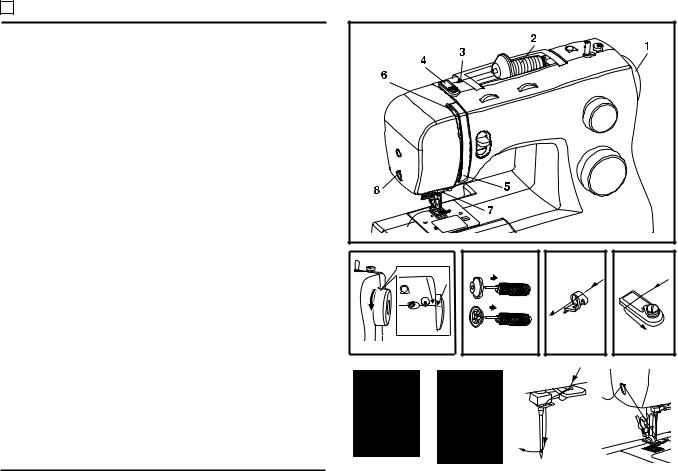
Threading the Upper Thread
This is a simple operation but it is important to carry out correctly as by not doing so several sewing problems could result.
-Start by raising the needle to its highest point (1), and continue turning the handwheel counterclockwise until the needle just slightly begins to descend. Raise the presser foot to release the tension discs.
Note: For safety, it is strongly suggested you turn off the power before threading.
-Lift up the spool pin. Place the spool of thread on the holder with the thread coming off the spool as shown. For small thread spools, place small side of spool holder next to spool. (2)
-Draw thread from spool through the upper thread guide (3) and pulling thread through pre-tension spring as illustrated.
(4)
-Thread tension module by leading thread down right channel and up left channel. (5) During this process it is helpful to hold the thread between the spool and thread guide.
-At the top of this movement pass thread from right to left through the slotted eye of the take-up lever and then downwards again. (6)
-Now pass the thread behind the horizontal thread guide, and then behind the thin wire needle clamp guide (7) and then down to the needle which should be threaded from front to back.
-Pull about 6-8 inches of thread to the rear beyond the needle eye. Trim thread to length with built in thread cutter. (8)
1 |
2 |
3 |
4 |
5 |
6 |
7 |
8 |
9
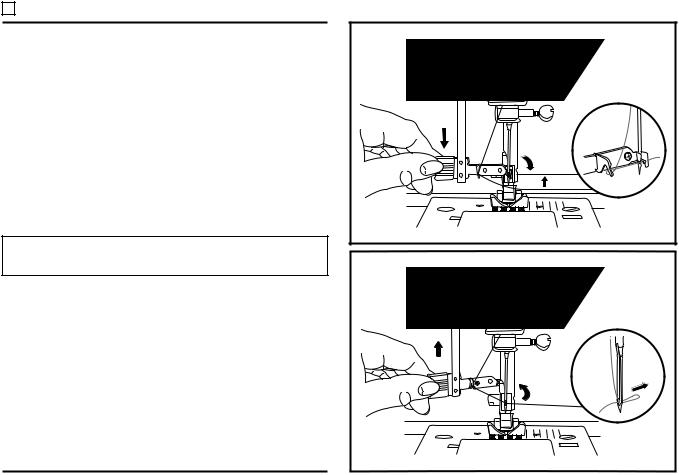
Automatic Needle Threader
-Raise the needle to its highest position.
-Press lever (A) down as far as it will go.
-The threader automatically swings to the threading position
(B).
- Pass thread around thread guide (C). |
A |
|
|
|
|
- Pass the thread in front of the needle around the hook (D) |
|
|
from bottom to top. |
|
B |
|
|
|
- Release lever (A). |
C |
D |
|
||
|
|
|
- Pull the thread through the needle eye. |
|
|
|
1 |
|
Attention: |
|
|
Turn power switch to off ("O")! |
|
|
A
2
10

Raising the Bobbin Thread
Hold the upper thread with the left hand. Turn the handwheel
(1) towards you (counterclockwise) lowering, then raising needle.
Note:
If it is difficult to raise the bobbin thread, check to make sure the thread is not trapped by the hinged cover or the Removable Extension Table.
1
Gently pull on the upper thread to bring the bobbin thread up through the needle plate hole. (2)
Lay both threads to the back under the presser foot. (3)
2
3 |
11
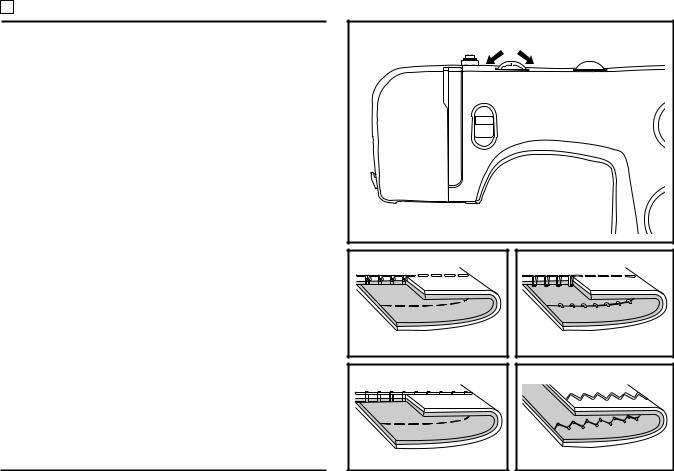
Thread Tension
Upper thread tension
Basic thread tension setting: "4". (1)
To increase the tension, turn the dial to the next number up. To reduce the tension, turn the dial to the next number down.
A.Normal thread tension for straight stitch sewing.
B.Thread tension too loose for straight stitch sewing. Turn dial to higher number.
C.Thread tension too tight for straight stitch sewing. Turn dial to lower number.
D.Normal thread tension for zig zag and decorative sewing. Correct thread tension is when a small amount of the upper thread appears on the bottom side of fabric.
Lower thread tension
The bobbin tension has been set correctly at the factory, so you do not need to adjust it.
Please note:
-Proper setting of tension is important to good sewing.
-There is no single tension setting appropriate for all stitch functions, thread or fabric.
-A balanced tension (identical stitches both top and bottom) is usually only desirable for straight stitch construction sewing.
-90% of all sewing will be between "3" and "5".
-For zig zag and decorative sewing stitch functions, thread tension should generally be less than for straight stitch sewing.
-For all decorative sewing you will always obtain a nicer stitch and less fabric puckering when the upper thread appears on the bottom side of your fabric.
1 |
|
A |
B |
C |
D |
12
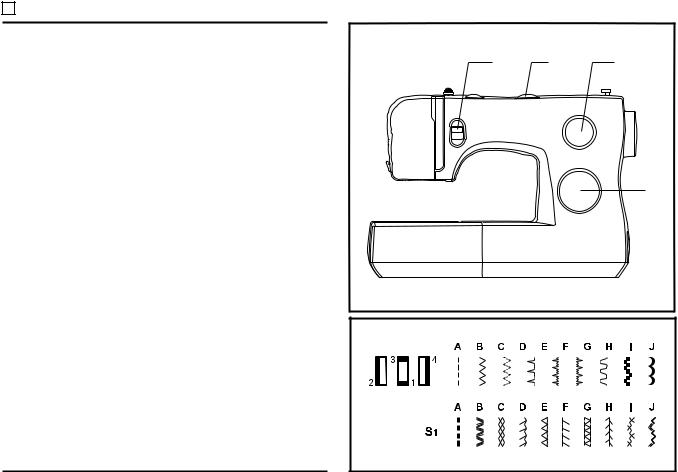
How to Choose Your Pattern
The diagram on this page display the stitch patterns available on the machine.
a |
b |
c |
Stitches in the top of the diagram are indicated on the Pattern Selector Dial in gray. To select the patterns indicated with the gray color, turn the Pattern Selector Dial. (d) Use the Stitch Length Dial (c) to adjust the stitch length as desired for the project. Use the Stitch Width Dial (b) to adjust the width of the stitch as desired.
Stitches in the bottom row of the diagram are indicated on
the Pattern Selector Dial in blue. The blue indicates that the d stitch is a stretch stitch pattern, and information on how to
sew these stretch patterns is on page 17.
The Pattern Selector Dial may be turned in either direction.
a.Reverse Sewing Lever
b.Stitch Width Dial
c. Stitch Length Dial
d. Pattern Selector Dial
13
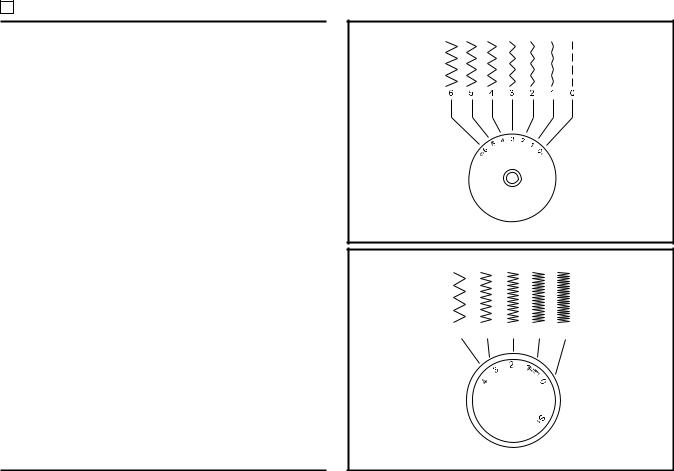
Stitch Width Dial & Stitch Length Dial
Function of stitch width dial
The maximum zigzag stitch width for zigzag stitching is 6mm; however, the width can be reduced on any patterns. The width increases as you move zigzag dial from "0" - "6". (1)
The Stitch Width Dial is also the control for the straight stitch infinite needle position. "0" is center needle position, "6" is full left.
Function of stitch length dial while zig-zag stitching
Set the Pattern Selector Dial to zig-zag.
The density of zig-zag stitches increase as the setting of stitch length dial approaches "0".
Neat zig-zag stitches are usually achieved at "3" or below. (2) Dense zig-zag stitches are called satin stitches. (2)
Function of stitch length dial for when straight stitching
For straight stitch sewing, turn the Pattern Selector Dial to the straight stitch setting. Turn the Stitch Length Dial, and the length of the individual stitches will decrease as the dial approached "0". The length of the individual stitches will increase as the dial approaches "4". Generally speaking, use a longer stitch length when sewing heavier weight fabrics or when using a thicker needle or thread. Use a shorter stitch length when sewing lighter weight fabrics or when using a finer needle or thread.
1
2
4 3 2 1 0.5
14
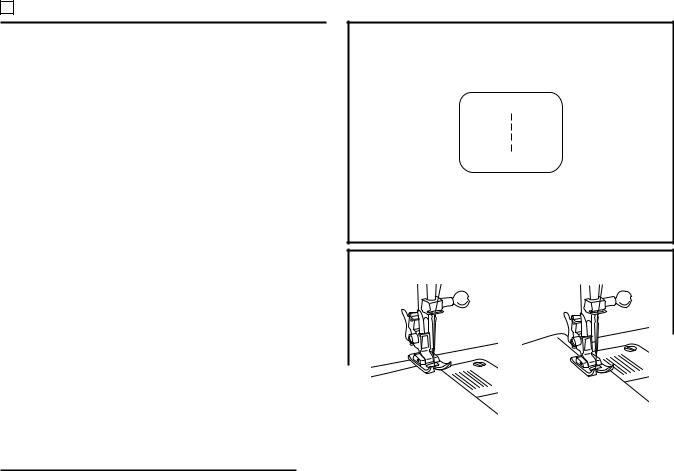
Sewing Straight Stitch
To begin sewing, set the machine for straight stitch. (1)
Place the fabric under the presser foot with the fabric edge lined up with the desired seam guide line on the needle plate.
(2)
Lower the presser foot lifter, and then step on the foot controller to start sewing. (3)
1
2 |
3 |
15
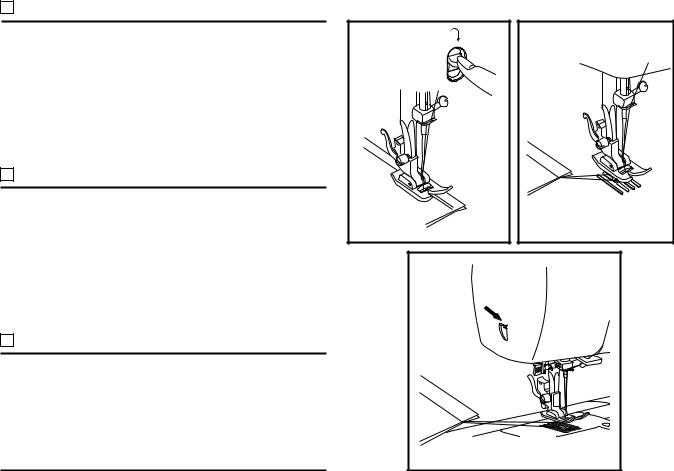
Reverse Sewing
To secure the beginning and the end of a seam, press down |
|
the reverse sewing lever (A). Sew a few reverse stitches. |
|
Release the lever and the machine will sew forward again. (1) |
A |
Removing the Work |
|
|
|
Turn the handwheel toward you (counterclockwise) to bring |
|
|
|
the thread take up lever to its highest position, raise the |
1 |
2 |
|
presser foot and remove work behind the needle and presser |
|||
|
|
||
foot. (2) |
|
|
|
|
|
B |
|
Cutting the Thread |
|
|
|
Pull the threads under and behind the presser foot. Guide |
|
|
|
the threads to the side of the face plate and into thread cutter |
|
|
|
(B). Pull threads down to cut. (3) |
|
|
|
|
|
3 |
16
